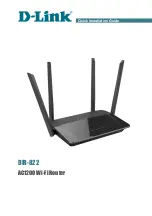
817
Configuring IP Unicast Routing
Configuring RIP
Switch(config-router)#
end
Configuring RIP
The Routing Information Protocol (RIP) is an interior gateway protocol (IGP) used in small, homogeneous networks. It is
a distance-vector routing protocol that uses broadcast User Datagram Protocol (UDP) data packets to exchange routing
information. You can find detailed information about RIP in
IP Routing Fundamentals,
published by
Cisco Press.
Using RIP, the switch sends routing information updates (advertisements) every 30 seconds. If a router does not receive
an update from another router for 180 seconds or more, it marks the routes served by that router as unusable. If there is
still no update after 240 seconds, the router removes all routing table entries for the non-updating router.
RIP uses hop counts to rate the value of different routes. The hop count is the number of routers that can be traversed
in a route. A directly connected network has a hop count of zero; a network with a hop count of 16 is unreachable. This
small range (0 to 15) makes RIP unsuitable for large networks.
If the router has a default network path, RIP advertises a route that links the router to the pseudonetwork 0.0.0.0. The
0.0.0.0 network does not exist, but is treated by RIP as a network to implement default routing. The switch advertises
the default network if a default was learned by RIP or if the router has a gateway of last resort and RIP is configured with
a default metric. RIP sends updates to the interfaces in specified networks. If an interface’s network is not specified, it
is not advertised in any RIP update.
This section includes the following topics:
Default RIP Configuration, page 818
Configuring Basic RIP Parameters, page 818
Configuring RIP Authentication, page 820
Содержание IE 4000
Страница 12: ...8 Configuration Overview Default Settings After Initial Switch Configuration ...
Страница 52: ...48 Configuring Interfaces Monitoring and Maintaining the Interfaces ...
Страница 108: ...104 Configuring Switch Clusters Additional References ...
Страница 128: ...124 Performing Switch Administration Additional References ...
Страница 130: ...126 Configuring PTP ...
Страница 140: ...136 Configuring CIP Additional References ...
Страница 146: ...142 Configuring SDM Templates Configuration Examples for Configuring SDM Templates ...
Страница 192: ...188 Configuring Switch Based Authentication Additional References ...
Страница 244: ...240 Configuring IEEE 802 1x Port Based Authentication Additional References ...
Страница 274: ...270 Configuring SGT Exchange Protocol over TCP SXP and Layer 3 Transport Configuring Cisco TrustSec Caching ...
Страница 298: ...294 Configuring VLANs Additional References ...
Страница 336: ...332 Configuring STP Additional References ...
Страница 408: ...404 Configuring DHCP Additional References ...
Страница 450: ...446 Configuring IGMP Snooping and MVR Additional References ...
Страница 490: ...486 Configuring SPAN and RSPAN Additional References ...
Страница 502: ...498 Configuring Layer 2 NAT ...
Страница 559: ...555 Configuring Network Security with ACLs How to Configure Network Security with ACLs Creating a Numbered Extended ACL ...
Страница 770: ...766 Configuring IPv6 MLD Snooping Related Documents ...
Страница 930: ...926 Configuring IP Unicast Routing Related Documents ...
Страница 956: ...952 Configuring IPv6 Unicast Routing Configuring IPv6 network 2010 AB8 2 48 network 2010 AB8 3 48 exit address family ...
Страница 976: ...972 Configuring Cisco IOS IP SLAs Operations Additional References ...
Страница 978: ...974 Dying Gasp ...
Страница 990: ...986 Configuring Enhanced Object Tracking Monitoring Enhanced Object Tracking ...
Страница 994: ...990 Configuring MODBUS TCP Displaying MODBUS TCP Information ...
Страница 996: ...992 Ethernet CFM ...
Страница 1030: ...1026 Working with the Cisco IOS File System Configuration Files and Software Images Working with Software Images ...
Страница 1066: ...1062 Using an SD Card SD Card Alarms ...
















































